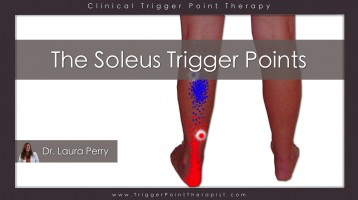The vastus lateralis trigger points refer pain to the outside of the thigh, knee, and upper lower leg. They may also cause the “stuck patella” or “locked knee cap” conditions in which the knee cap fails to track up and down naturally during movements of the knee.
Tibialis Posterior Trigger Point: Sneaky Achilles Tendonitis
The tibialis posterior trigger point is a sneaky-little-booger of a trigger point that few people know about. It lies deep in the calf musculature and causes intense pain and burning in the Achilles tendon region. The pain will also frequently spread to the calf, the heel, and over the entire surface of the sole of the foot (including the bottom of the toes).
Tibialis Anterior Trigger Point: The Foot Drop Trigger Point
The tibialis anterior trigger point causes pain in the front of the ankle and on the big toe. This trigger point also weakens the tibialis anterior muscle which is responsible for raising (and lowering) the foot at the ankle as you walk. So when someone with this trigger point tries to take a normal step, their foot kind of drags behind and then slaps down after their heel strikes the ground. This is called foot drop and foot slap, respectively.
Adductor Magnus Trigger Point: The PMS Trigger Point
Would you believe me if I told you that the monthly scourge that disrupts the lives of women everywhere could be easily beaten back with a simple trigger point therapy technique? If you are a woman, probably not. (If you are a man, well your opinion just doesn’t matter in this situation, ha ha.)
Soleus Trigger Points and Runner’s Heel Pain
The soleus is the wide, flat muscle that covers and shapes the calf region of the lower leg. The “claim to fame” of one of the trigger points in this muscle is the heel pain that many joggers and runners experience during and after exercise. It (along with the tibialis posterior trigger point) can also produce pain the Achilles tendon region as well. Other trigger points in the soleus produce pain and tenderness in the calf region and rarely even way up in the sacroiliac joint of the low back region.
- « Previous Page
- 1
- 2
- 3
- 4
- …
- 9
- Next Page »




